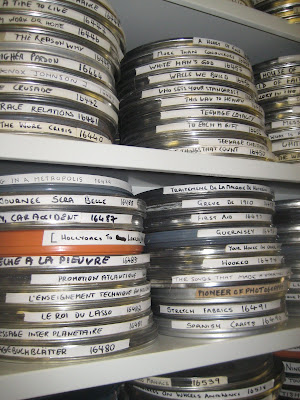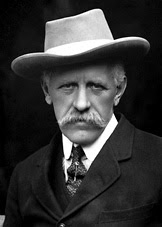
View of the Huntley Film Archive
Huntley Film Archives and Skillset will be holding a five day residential course in the
This intensive and very hands on course will help you evaluate, manage and utilise moving image collections to be held on Sunday 18th April to Friday 23rd April 2010
By the end of the course, you will be able to :
- assess and evaluate archive film and other moving image collections
- learn how to handle all formats and gauges
- develop a preservation plan, address cataloguing issues and copying
- utilise and exploit those collections for the broadcast, education and other creative media
For more information, a full timetable and booking form caroline@huntleyarchives.com
Working with the Lindsay Anderson Collection has really fuelled and intensified my passion for film (unsurprisingly) and has made me determined to continue my career in the realm of film archives. So in November of last year I jumped at the opportunity to attend a residential training course at the Huntley Film Archives, near Hereford. Entitled 'Film Archives: a practical management guide' the course was absolutely full of useful, practical and interesting education and training. I really couldn't overemphasise how friendly and welcoming Amanda and John Huntley, Caroline Jenkins and the guest tutors were.

I've been meaning to write about the week for ages now but had a wee bit of a hiatus from the blog in December - partly due to lots of work, but also enjoying being away from a computer over the Christmas holidays! So, I thought this was the perfect time to write about the week at Huntley Film Archives as they are now advertising for their Spring course - which I would recommend to anyone interested in working in the field of audiovisual archives, or indeed to anyone interested in film who would like to gain more of an understanding of the issues of preservation and access.
After an epic train journey from Glasgow to Leamington Spa, then Leamington Spa to Hereford on the Sunday I arrived in Hereford in the dark. I was met at the station by Robert Dewar and, along with two other participants on the course, Rachael and David P, we set off for the Archives. Driving deep into the countryside we pulled up outside a beautiful big house, I couldn't believe that as well as learning about something that I'm passionate about, I was also going to get to spend a week in such lovely surroundings! There were eight of us on the course and the week started with a dinner in the local pub on the Sunday evening - the perfect opportunity for us to get to know each other. There were a variety of reasons people were doing the course, and a range of levels of experience of working with moving image archives.
Monday morning started with a very interesting talk by Amanda Huntley on the history of film and television from it's beginnings right up to the present day. This was followed by a tour of the vault and a discussion of the various gauges and formats used in the film industry. We then got some practical experience in how to identify types of film gauges and tape formats, how to identify nitrate film and how to date films. The afternoon session was taken by Richard Shenton from MACE (Media Archive for Central England) where we looked at the history of sounds and colour in films, as well as having a workshop in how to identify different sounds formats and colour processes. When I first read the timetable and noticed that the archive will be open 7-10 every night I remember thinking - that's a bit much! Indeed we discussed it on the first evening there and the general consensus was we'd be too full of information by the end of the day to go back in the evening. However, guess what, every single night after dinner, we would find ourselves back in the archive, asking more questions and getting more valuable experience of using the Steenbecks. The second day started with a hands-on session of using the Steenbecks - very intimidating but, knowing that we had expert guidance, we all really enjoyed it!
Rachael using a Steenbeck

David S. using a Steenbeck

Me (Kathryn Mackenzie) using a Steenbeck
Tuesday continued with a very useful afternoon class on preservation and restoration. We learned about the dangers of incorrect storage, we saw how films should be stored, and we had a go at removing mould from films. In the evening there was a film show which was great fun, and really interesting. A number of people had brought along films from their archives and Amanda and Robert had some from the Huntley Archive and we had a lovely evening of watching films, chatting and drinking wine!On Wednesday we looked at film archives from the perspective of the television producer and television researcher. For someone with no experience in a commercial film archives this was all new to me, but all expertly explained by Amanda Huntley and the guest speaker, Steve Humphries. Then Wednesday afternoon was devoted to cataloguing - my favourite job! That isn't sarcasm at all, I really do love cataloguing, it's what I spend most of my time doing. However in cataloguing films, as opposed to film-related records, found that the style of description used and the types of information that are recorded varied significantly from the work that I do. For this reason alone it was a very valuable afternoon, but it was also just a lot of fun to get 'let loose' with real films and get a chance to catalogue.
Thursday morning Amanda Huntley led a very informative session on exploiting your film archive. Although at present i don't work in an archive dealing with films I still found this a useful session and feel that I learnt a lot about the different types of uses of film archives, and the way to get the most out of your archive. Thursday afternoon we got some expert advice from Belinda Harris, a Director of All Rights Clearance. This was pretty eye-opening stuff on the costs of copyright clearance, although the minefield that is copyright law is a familiar issue for archivists in any realm.
Friday was an overview of the week and some very helpful expert advice for each of us on our next step in furthering our careers. All the experts and teachers on the course were so helpful and friendly. The welcome from Amanda Huntley, Robert Dewar and Caroline Jenkins made us all feel instantly comfortable and able to ask questions and the informal evening sessions were of great benefit. Oh, and I couldn't write about the Huntley Film Archive without including a photograph of the Llama's - just one more aspect of the course that made it so enjoyable!







